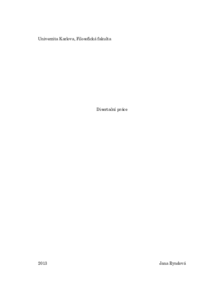Drama "Jošicune mezi květy sakur". Minamoto no Jošicune jako stratég, dvořan a literární mýtus.
The drama "Yoshitsune and the thousand cherry trees." Minamoto No Yoshitsune as a martial strategist, courtier and literary myth.
dissertation thesis (DEFENDED)

View/
Permanent link
http://hdl.handle.net/20.500.11956/59995Identifiers
Study Information System: 134791
CU Caralogue: 990016268830106986
Collections
- Kvalifikační práce [24665]
Author
Advisor
Referee
Rumánek, Ivan
Hýbl, Ondřej
Faculty / Institute
Faculty of Arts
Discipline
Literatures of Asia and Africa
Department
Department of Sinology
Date of defense
20. 9. 2013
Publisher
Univerzita Karlova, Filozofická fakultaLanguage
Czech
Grade
Pass
Keywords (Czech)
Minamoto no Jošicune, historická postava, hrdina, hrdinství, hrdinský, válečný epos, legenda, literární mýtus, literární postava, drama, žánr kówakamai (deklamace doprovázená minimalistickým tancem), divadlo nó, divadlo bunraku (džóruri), divadlo kabuki, Jošicune mezi květy sakur (Jošicune senbon zakura), Jan Mukařovský, estetická hodnota, kolektivní vědomíKeywords (English)
Minamoto no Yoshitsune, historical figure, hero, heroism, heroic, martial epic, legend, literary myth, literary figure (character), drama, kowakamai (declamation accompanied by minimalistic dance), noh theatre, bunraku (joruri), kabuki, Yoshitsune and the Thousand Cherry Trees (Yoshitsune senbon zakura), Jan Mukařovský, aesthetic value, collective mindAutorka si v rámci disertační práce klade za cíl představit hru Jošicune mezi květy sakur (Jošicune senbon zakura) jakožto unikátní dílo japonského dramatu, které se vyznačuje značnou komplexností a zaujímá výjimečné místo v korpusu japonské literatury. Třebaže uvedená hra je co do svého významu srovnatelná s díly zpracovávajícími známou legendu o čtyřiceti sedmi věrných róninech, není ve větší míře přeložena do západních jazyků. Jsou zde ovšem dvě výjimky: anglický překlad (Jones, Jr. 1993) a německý překlad (Klopfenstein 1982). Autorka při zpracovávání disertační práce vycházela ze srovnání těchto dvou překladů a z úplné verze původního textu (v podobě, ve které se text objevuje ve Sbírce textů divadla džóruri Takedy Izumoa a Namiki Sósukeho a ve Sbírce textů loutkového divadla džóruri Júdy Jošia). Záměrem autorky bylo zprostředkování jmenované hry české čtenářské a odborné veřejnosti. Interpretaci hry Jošicune mezi květy sakur autorka začíná výkladem historického pozadí, ze kterého vzešla legenda o vojevůdci Jošicunem z rodu Minamoto. Tento výklad zahrnuje Jošicuneho život od období nepokojů éry Heidži (1159) kdy se narodil do jeho smrti (1189). Dále se autorka soustředí na vývoj, kterým prošla Jošicuneho legenda v rámci vývoje japonské literarury. Dochází zde k posunu od dvorské literatury...
In her doctoral thesis the author would like to present the play Yoshitsune and the Thousand Cherry trees (Yoshitsune senbonzakura) as a unique piece of Japanese drama which has a great complexity and an outstanding place within the corpus of Japanese literature. Even if the play can be compared to Chushingura mono in its importance, Yoshitsune senbonzakura has not been widely translated to western languages. There are two exceptions, however: the English translation (Jones, Jr. 1993) and the German translation (Klopfenstein 1982). While comparing the two translations and using the most full original texts available (as preserved in Takeda Izumo and Namiki Sosuke Joruri Collection and Yuda Yoshio's Bunraku Joruri Collection), the author's goal is to present the play to Czech readers and its interpretation to Czech scholars. As for the flow and structure of the interpretation of Yoshitsune senbonzakura the author begins with an analysis of the historical background of the legend of Minamoto Yoshitsune, capturing the life of Yoshitsune from the time of Heiji rebellion (1159) when he was born to his death in 1189. Next the author concentrates on the legend itself as it evolved within the course of Japanese literature. With a shift from the court literature of Heian period towards the battlefield...
